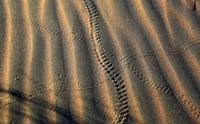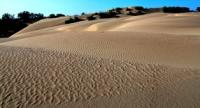You are here
Sands Big Barsuki.


A trip to the sands of Big Barsuki.
“Night poured over the desert. It came suddenly, in purple. In the clear air, the stars drilled down out of the sky, reminding any thoughtful watcher that it is in the deserts and high places that religions are generated. When men see nothing but bottomless infinity over their heads they have always had a driving and desperate urge to find someone to put in the wa”
Terry Pratchett, “Jingo”.
A trip from the Aral Sea through the sands of Big Barsuki.
The main area, Sands Bolshoi Barsuki are located in the Aktobe region and only a small southeastern part of the sand is in the Kyzylorda region. Sands Big Barsuki are located on the western side of the Small Aral Sea.
Sands are stretched from southwest to northeast for 260.6 kilometers, the greatest width in the southern part is 34 kilometers. The highest sand height in the southern part reaches 137 meters above sea level, in the northern part 201 meters above sea level. In the southern part, the sands border the small village of Kulandy, which is located in the Aral region of the Kyzylorda region.
In the northwestern part of the sand, Big Barsuki is a large village and the railway station Shalkar. Through the northern part of the sands, from the southeast to the northwest, the Kyzylorda-Aktobe railway runs 18 kilometers long.
In the northern part of the sands on the western side is the large salt lake Shalkar. In the northeast, the sands border the western extremity with Moyynkum sand. In the southern part of the sands, from the west is located Koshkar ata litter.
In the west of the sands stretch the plateau Donyztau and Shagyray. The sands of Big Badgers are occupied by depressions, stretching south from the Turgai hollow and separated by a strip of radical relief. Sandy massifs consist predominantly of sands of Paleogene, and only in the northwestern part of the Big Barsuki are alluvial deposits found.
The wind forms ridges and dunes out of sand; in the flat areas, sand is fixed by xerophytic shrubs, wormwood, hodgepodge and ephemera. On the slopes of the hillocks and ridges there are thickets of juzgun, sand acacia, shrub astragalus, kandym and chingil.
There are unique artificial plantations of woody vegetation (pine, aspen, jida). Trees grow in small groves up to 0.5 ha, reaching a height of 10 - 12 meters. The territory of the desert is used for grazing, especially in summer, when there is a sufficient amount of water (a relatively high level of standing groundwater).
The climate is sharply continental with frosty windy winters and hot, dry summers. The average annual rainfall is 150 - 200 mm.
Aurhority:
Alexander Petrov. http://dic.academic.ru
Photos
Alexander Petrov.







